Three Bird Orchid, Threebirds, Nodding Pogonia, Nodding Ettercap - Triphora trianthophoros
|
Triphora trianthophoros - Three Bird Orchid, Threebirds, Nodding Pogonia, Nodding Ettercap.
Triphora is a small genus of about 10 to 25 orchid species found in the Americas and West Indies. Of these, 5 are found in the United States (2 more in U.S. territory Puerto Rico). Of the mainland species, 4 are found only in Florida.
Triphora trianthophoros is widely scattered across the eastern United States and is found in Ontario Canada, in Mexico, and in Central America. While the distribution is wide, it is classified as rare or threatened in most states where it is found and is protected in 13 states. There are two subspecies of Triphora trianthophoros - ssp. trianthophoros, and ssp. mexicana. Only ssp. trianthophoros is found north of Mexico.
Triphora trianthophoros is rarely seen even in the states where it is not classified as rare due to the ephemeral nature of its blooming. As with many orchids it may go dormant for several years (there is one report of a possible dormancy for 125 years!) In years that it blooms it is usually in August or early September, with an entire population (which can be hundreds or thousands of plants) blooming at the same time. Each flower remains fresh for only a single day, so with a few flowers per plant the population will have flowers in bloom only for a few days. There are several folklore stories on how to know when it will bloom - 48 hours after 2 consecutive days of drops in the morning low temperatures after the first of August, and during the first week after the first drenching rain in August. However, depending on location, the plant may bloom as early as late July, or as late as mid-September. In any case, hurry when you hear a report that it is blooming; these photos were taken on the third day after the initial report of bloom, and relatively few plants were still blooming.
Many authorities (apparently incorrectly) use the name Triphora trianthophora for this plant.
Found in:
AL, AR, CT, DC, DE, FL, GA, IA, IL, IN, KS, KY, LA, MA, MD, ME, MI, MO, MS, NC, NE, NH, NJ, NY, OH, OK, PA, SC, TN, TX, VA, VT, WI, WV, GS
Leave comments on Triphora trianthophoros at this link. | 
Distribution of Triphora trianthophoros in the United States and Canada:

Map courtesy of The Biota of North America Program.
Map color key
Search Our Database: Enter any portion of the Scientific, Common Name, or both.
Do a general Google search of the entire site:
#ad
 Follow USWildflowers on Twitter
#ad
| | Site: GSMNP, Sevier County, TN Date: 2018-August-07 | Photographer: Gerald C. Williamson
Nikon D7000
Tamron SP 90MM f/2.8 AF Macro | | When the flower of Three Birds Orchid is fresh, the sepals and lateral petals are raised, giving some folks the impression of a bird-like appearance, with the lip appearing to be the beak. The flower is white, white tinged with pink, or pale pink. It is less than .75 inches long. | | 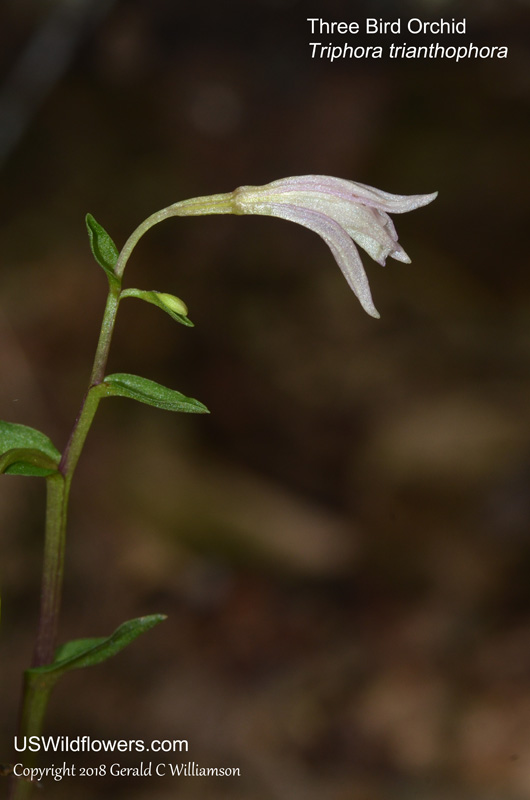
| | Site: GSMNP Sevier County, TN Date: 2018-August-07 | Photographer: Gerald C Williamson
Nikon D7000 | | The small flower of Three Birds Orchid is no more than .75 inches long. The 3 sepals and lateral 2 petals are similar in appearance, and are ascending. The lip is 3-lobed, and has 3 bumpy green ridges. | | Click on the photo for a larger image
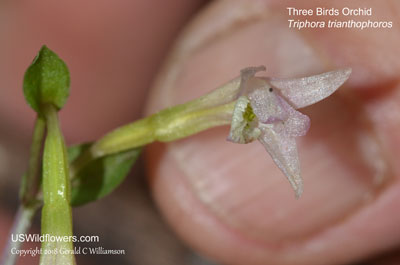
| | Site: GSMNP Sevier County, TN Date: 2018-August-07 | Photographer: Gerald C Williamson
Nikon D7000 | | Triphora trianthophoros is from 2 to 12 inches tall; this particular plant is about 4 inches tall. While the plant may have from 1 to 6 axillary flowers, 3 is considered "normal" - thus the "Three Birds" name. While a plant may have more than one flower at a time, this one may be more typical, with one flower blooming, one still a bud laying on the 2nd leaf from the top, and a third having already bloomed. | | Click on the photo for a larger image
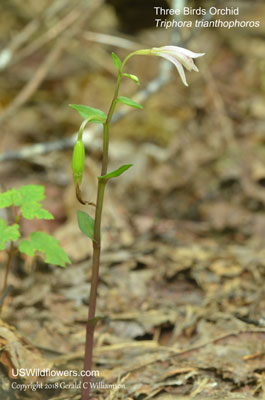
| | Site: GSMNP Sevier County, TN Date: 2018-August-07 | Photographer: Gerald C Williamson
Nikon D7000 | | The fruit of Triphora trianthophoros is a capsule containing hundreds of tiny, dust-like seeds, which may rely on wind for dispersal. The plant has a low pollination rate, and may rely on vegetative reproduction from splitting of the underground tubers and separation of the stolons for propagation, rather than relying solely on seed dispersal. | | Click on the photo for a larger image
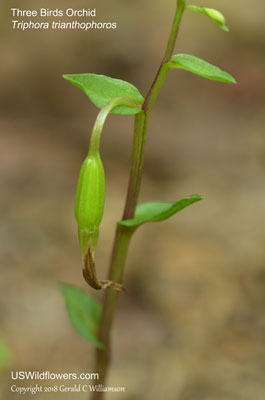
| | Site: GSMNP Sevier County, TN Date: 2018-August-07 | Photographer: Gerald C Williamson
Nikon D7000 | | The leaves of Three Birds Orchid are alternate on the stem, ovate, and clasping the stem. There are typically 3 to 6 leaves which are less than .75 inches long. Due to the small surface area of the leaves, it is believed that the plants do not rely entirely on photosynthesis for their nutrients, and since they grow primarily in leaf litter and on rotting logs, they may be semi-saprophytic, getting some of their energy from dead and decaying organic material. | | Click on the photo for a larger image
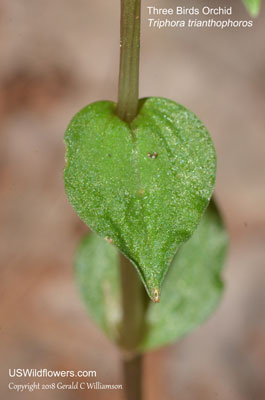
|
References used for identification and information:
- Ramstetter, Jennifer M. 2001. New England Plant Conservation Program Conservation and Research Plan, Triphora trianthophora (Swartz) Rydb, Three-birds Orchid (PDF, 168 KB). New England Wild Flower Society, Framingham, Massachusetts, USA.
- Philipps, Thomas C - Three Birds Orchid, USDA Forest Service
- Lady Bird Johnson Wildflower Center - The University of Texas at Austin
- Weakley's Flora of the Southern and Mid-Atlantic States (2015)
- Flora of North America Editorial Committee, eds. 1993+. Flora of North America North of Mexico. 16+ vols. New York and Oxford.
- North American Orchid Center
|
|
| |
| #ad
|
|







